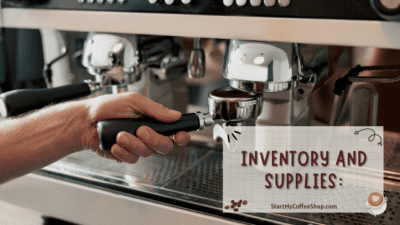Coffee shops have become an integral part of our daily lives, serving as social hubs and sanctuaries for caffeine enthusiasts. However, behind the aromatic brew and cozy ambiance, lies the complex world of running a coffee shop.
Running a coffee shop can involve various expenses, rent, utilities, employee wages, inventory, equipment maintenance, marketing, licenses, permits, and insurance. A rough estimate for starting a small to medium-sized coffee shop ranges from $80,000 to $300,000.
In this article, I will delve into the various factors that contribute to the cost of running a coffee shop.
Location and Rent:
Selecting the right location is paramount for a coffee shop’s prosperity and financial feasibility. The significance of prime locations with bustling foot traffic cannot be overstated, albeit at a substantial cost that can consume a considerable chunk of the budget. Rent expenses fluctuate based on factors like city, neighborhood, and square footage. Striking a delicate equilibrium between visibility and affordability becomes imperative.
Opting for a prime location grants the advantage of attracting a steady stream of potential customers. Areas near busy commercial districts, universities, or popular tourist destinations can offer an influx of foot traffic, increasing the likelihood of capturing a significant share of the market. However, such sought-after locations often demand higher rents due to the desirability and competition for limited space.
On the other hand, more affordable locations may be available in quieter neighborhoods or areas slightly removed from the city center. While these locations may not offer the same level of foot traffic, they often come with lower rental costs, allowing for more manageable financial planning. Finding a balance between visibility and affordability is crucial, ensuring that the coffee shop can attract a steady flow of customers while maintaining a sustainable financial model.
Ultimately, the decision on location should consider factors such as target audience, competition, accessibility, and the unique value proposition of the coffee shop. Thorough research and careful analysis of potential locations can help strike the right balance between attracting customers and managing costs effectively.
Equipment and Furnishings:
Equipping a coffee shop goes beyond purchasing commercial-grade coffee machines, grinders, espresso makers, blenders, and refrigeration units. It requires careful consideration of the quality and durability of the equipment to ensure seamless operations. Investing in reliable and efficient equipment minimizes downtime, reduces maintenance costs, and enhances the overall customer experience.
Moreover, the interior furnishings, seating arrangements, and decor play a significant role in shaping the ambiance of the coffee shop. Comfortable seating options, cozy couches, and aesthetically pleasing decor create an inviting atmosphere that entices customers to relax and enjoy their coffee. Thoughtful interior design choices, such as warm lighting, natural elements, and appealing artwork, contribute to a positive and memorable customer experience.
The layout and organization of the coffee shop also deserve attention. Efficient use of space ensures smooth traffic flow and optimizes customer seating capacity. Creating designated areas for ordering, pickup, and seating, as well as providing accessible amenities like restrooms and Wi-Fi, enhances convenience and customer satisfaction.
By investing in high-quality equipment and creating an appealing interior atmosphere, a coffee shop can establish its unique identity and stand out from the competition. Customers are drawn not only to the quality of the coffee but also to the overall experience and ambiance provided. A well-equipped and thoughtfully designed coffee shop becomes a haven where customers can unwind, socialize, and savor their favorite brews.
Inventory and Supplies:
The improvement of a coffee shop hinges on the availability of a consistent supply of high-quality coffee beans, tea leaves, milk, syrups, and other essential ingredients. Effective inventory management and timely restocking are vital to ensure uninterrupted service and meet customer demands.

Maintaining a well-managed inventory involves understanding customer preferences and consumption patterns. Analyzing data on popular beverages, peak hours, and seasonal trends allows coffee shop owners to anticipate and optimize inventory levels accordingly. By stocking the right quantities of ingredients, waste can be minimized, and cost efficiencies can be achieved.
Regular communication and collaboration with suppliers are crucial to ensure a steady and reliable supply chain. Establishing strong relationships with trusted vendors helps in securing timely deliveries and mitigating potential disruptions in the availability of ingredients.
Additionally, embracing technology can aid in inventory management. Utilizing point-of-sale systems and inventory tracking software allows for real-time monitoring of stock levels, automatic alerts for low inventory, and streamlined restocking processes. Such tools enable coffee shop owners to make data-driven decisions, minimize waste, and keep their inventory optimized.
Read more about Cost to Start Coffee Shop Business: The Unfiltered Finances
Employee Wages and Benefits:
Skilled and friendly baristas are the backbone of a thriving coffee shop. Budgeting for employee wages, including salaries, hourly rates, and potential benefits, constitutes a substantial expense for coffee shop owners. Recognizing the value of a well-compensated workforce, businesses must allocate funds to attract and retain talented baristas who can deliver exceptional service.
Investing in training programs and ongoing development initiatives is essential to nurture a competent and motivated workforce. Baristas should receive comprehensive training on coffee brewing techniques, specialty beverage preparation, customer service, and hygiene standards. Ongoing skill enhancement workshops and industry certifications can further elevate the expertise of the baristas, ensuring consistent quality in every cup.
Compliance with labor laws is imperative to protect both the rights of employees and the coffee shop’s reputation. Adhering to minimum wage requirements, providing appropriate breaks, and maintaining accurate records are essential aspects of labor law compliance. Additionally, offering benefits such as healthcare coverage, retirement plans, and paid time off can help attract and retain top talent in a competitive job market.
Creating a fair and rewarding work environment fosters employee satisfaction and loyalty. Encouraging open communication, recognizing achievements, and providing opportunities for growth and advancement contribute to a positive workplace culture. Regular feedback, performance evaluations, and incentives for exceptional service can motivate baristas to go the extra mile and provide an outstanding customer experience.
By prioritizing the well-being and professional development of their baristas, coffee shop owners can cultivate a dedicated team that takes pride in their work. A skilled and motivated workforce not only enhances the overall quality of service but also contributes to customer loyalty and business growth.
Utilities and Operational Costs:
Running a coffee shop entails consistent expenses, including utilities such as electricity, water, heating, and cooling. The cost of these utilities depends on factors like the size of the coffee shop and the efficiency of the equipment used. Implementing energy-saving measures, like LED lighting and energy-efficient appliances, can help reduce utility costs over time.
In addition to utilities, there are various operational costs to consider. Acquiring licenses and permits, such as health permits and business licenses, is necessary to operate legally. Insurance coverage, including general liability and property insurance, safeguards the coffee shop from unforeseen events or accidents.
Marketing and advertising expenses are crucial for promoting the coffee shop and attracting customers. These costs may include social media advertising, print materials, signage, and collaborations with influencers or local businesses. Implementing a reliable point-of-sale system enables efficient transaction processing and inventory management while providing Wi-Fi access enhances the customer experience.
Cleaning supplies, including detergents, sanitizers, and disposable items, are essential for maintaining a clean and hygienic environment. Regular maintenance services for equipment, plumbing, and other facilities ensure their optimal functioning and prevent costly repairs down the line.
Careful budgeting and cost management are necessary to sustain these operational expenses. Regularly reviewing and optimizing these costs can help identify areas where savings can be made without compromising the quality of service or customer experience. By staying vigilant with expenses, coffee shop owners can maintain financial stability and ensure the smooth operation of their establishment.
Marketing and Promotion:
In today’s competitive market, strategic marketing and promotion are crucial for a coffee shop to stand out, attract customers, and build brand awareness. Allocating resources to advertising campaigns, social media management, website development, and engaging content creation can have a significant impact on the coffee shop’s visibility and customer acquisition.

Investing in well-planned advertising campaigns allows the coffee shop to reach a wider audience through various channels, such as print media, online platforms, or radio. Social media management plays a vital role in connecting with customers, sharing updates, and showcasing the coffee shop’s unique offerings. Developing an appealing website that is user-friendly and visually appealing provides an online platform for customers to learn more about the coffee shop and its menu.
Creating engaging content, such as blog posts, videos, or interactive social media posts, helps to captivate the target audience and generate interest in the coffee shop. Collaborating with local influencers who have a strong online presence and community following can help extend the reach and credibility of the coffee shop’s brand.
Moreover, community engagement initiatives, such as sponsoring local events, partnering with local charities, or hosting coffee tastings, foster a sense of connection with the community and build a positive reputation for the coffee shop.
By investing in effective marketing strategies and engaging with the target audience, a coffee shop can differentiate itself from competitors, attract new customers, and establish a strong brand presence in the market.
Read more about Cost to Start Drive-Thru Coffee Shop: A Cupful of Expenses
Contingency and Miscellaneous Expenses:
In running a coffee shop, it is prudent to allocate a portion of the budget for unforeseen circumstances and miscellaneous expenses. Unexpected events can arise, such as equipment breakdowns or repairs, which can disrupt operations and require immediate attention. Setting aside funds for such contingencies helps mitigate the financial impact and ensures a swift resolution to maintain smooth operations.
Additionally, staff turnover is an inevitable part of any business. Unexpected resignations or the need for sudden replacements can incur costs associated with recruitment, training, and onboarding. By having a contingency fund, the coffee shop can address these unexpected staffing needs without straining the budget or compromising the quality of service.
Legal fees can also unexpectedly arise due to various reasons, such as regulatory compliance, contract disputes, or unforeseen circumstances. Having a reserve for such expenses helps cover legal costs and ensures the coffee shop can address any legal issues that may arise while protecting its interests.
Emergencies, such as natural disasters or unforeseen events, may require immediate action and financial resources. Whether it’s property damage, temporary closure, or other emergencies, having a contingency fund allows the coffee shop to navigate these challenging situations, recover swiftly, and resume operations as soon as possible.
Summary
Running a coffee shop requires careful financial planning and management. While costs can vary based on numerous factors, including location, size, and target market, understanding the key expenses involved is crucial for progress.
From rent and equipment to inventory, employee wages, and marketing, each aspect contributes to the overall cost of running a coffee shop. By analyzing these financial factors and making informed decisions, aspiring cafe owners can embark on a caffeinated journey with confidence.
So, brew on, and may your coffee shop thrive!
Frequently Asked Questions

What are the ongoing expenses of running a coffee shop?
Running a coffee shop incurs several ongoing expenses, including rent, utilities, employee wages, inventory, equipment maintenance, marketing, licenses, permits, insurance, and operational costs.
How much does it cost to hire and train employees for a coffee shop?
Employee wages can vary depending on factors like location and experience. On average, baristas’ hourly wages range from $9 to $15.
How much inventory should I stock for a coffee shop?
It’s important to strike a balance between having enough stock to meet customer orders without incurring excessive waste. Monitoring sales data and implementing inventory management systems can help optimize inventory levels.
To learn more on how to start your own coffee shop checkout my startup documents here
Please note: This blog post is for educational purposes only and does not constitute legal advice. Please consult a legal expert to address your specific needs.

Hi! I’m Shawn Chun
My adventure in coffee began when I first launched my first coffee shop back in the early 2000s. I had to figure out so many things on my own and to make it worse within 2 years of opening two large corporate coffee chains moved in just blocks away from me!
As I saw smaller and even some larger coffee shops in the neighborhood slowly lose customers to these giant coffee chains and slowly close up shop, I knew that I had to start getting creative…or go out of business.
I (like you may be) knew the coffee industry well. I could make the best latte art around and the foam on my caps was the fluffiest you have ever seen. I even had the best state-of-the-art 2 group digital Nuova Simonelli machine money could buy. But I knew that these things alone would not be enough to lure customers away from the name brand established coffee shops.
Eventually, through lots of trial and error as well as perseverance and creativity I did find a way to not only survive but also thrive in the coffee/espresso industry even while those corporate coffee chains stayed put. During those years I learned to adapt and always faced new challenges. It was not always easy, however, in the end, I was the sole survivor independent coffee shop within a 10-mile radius of my location. Just two corporate coffee chains and I were left after that year. All told the corporate coffee chains took down over 15 small independent coffee shops and kiosks and I was the last one standing and thriving.
Along the years I meet others with the same passion for coffee and I quickly learned that it is not only “how good a barista is” that makes a coffee shop successful, but the business side of coffee as well.
Hence why I started this website you are on now. To provide the tools and resources for up and coming coffee shop owners to gain that vital insight and knowledge on how to start a coffee shop successfully.
Stick around, browse through my helpful blog and resources and enjoy your stay! With lots of LATTE LOVE!
Shawn







